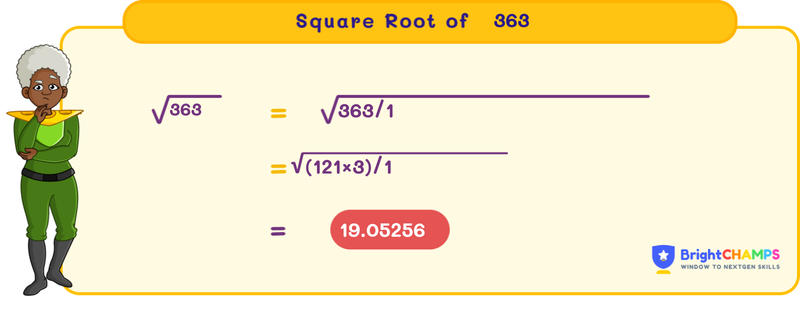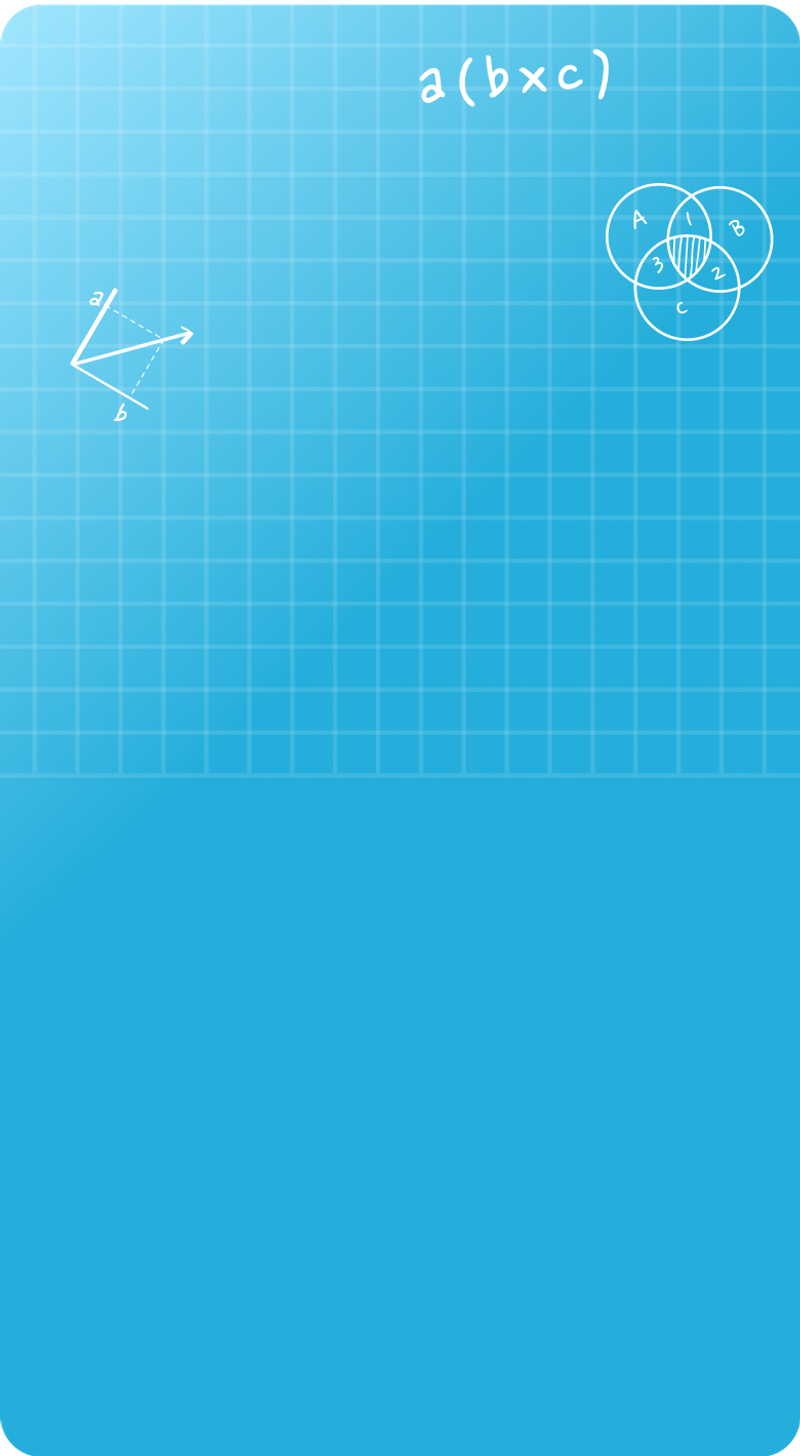Summarize this article:
 174 Learners
174 LearnersLast updated on 5 August 2025
Square Root of 363

If a number is multiplied by the same number, the result is a square. The inverse of the square is a square root. The square root is used in the field of vehicle design, finance, etc. Here, we will discuss the square root of 363.

What is the Square Root of 363?
The square root is the inverse of the square of the number. 363 is not a perfect square. The square root of 363 is expressed in both radical and exponential form. In the radical form, it is expressed as √363, whereas (363)^(1/2) in the exponential form. The square root of 363 is approximately 19.0526, which is an irrational number because it cannot be expressed in the form of p/q, where p and q are integers and q ≠ 0.

Finding the Square Root of 363
The prime factorization method is used for perfect square numbers. However, for non-perfect square numbers, the long division method and approximation method are used. Let us now learn the following methods:
- Prime factorization method
- Long division method
- Approximation method

Square Root of 363 by Prime Factorization Method
The product of prime factors is the prime factorization of a number. Now let us look at how 363 is broken down into its prime factors.
Step 1: Finding the prime factors of 363 Breaking it down, we get 3 x 11 x 11: 3^1 x 11^2
Step 2: Now we found out the prime factors of 363. The second step is to make pairs of those prime factors. Since 363 is not a perfect square, the digits of the number can’t be grouped entirely in pairs.
Therefore, calculating 363 using prime factorization directly to find a perfect square root is not possible.

Square Root of 363 by Long Division Method
The long division method is particularly used for non-perfect square numbers. In this method, we should check the closest perfect square number for the given number. Let us now learn how to find the square root using the long division method, step by step.
Step 1: To begin with, we need to group the numbers from right to left. In the case of 363, we need to group it as 63 and 3.
Step 2: Now we need to find n whose square is less than or equal to 3. We can say n as ‘1’ because 1 x 1 is lesser than or equal to 3. Now the quotient is 1, and after subtracting 1 from 3, the remainder is 2.
Step 3: Now let us bring down 63, making the new dividend 263. Add the old divisor with the same number 1 + 1, we get 2, which will be our new divisor.
Step 4: The new divisor will be the sum of the original divisor and quotient. Now we get 2n as the new divisor, and we need to find the value of n.
Step 5: The next step is finding 2n x n ≤ 263. Let us consider n as 9, now 29 x 9 = 261.
Step 6: Subtract 261 from 263; the difference is 2, and the quotient is 19.
Step 7: Since the dividend is less than the divisor, we need to add a decimal point. Adding the decimal point allows us to add two zeroes to the dividend. Now the new dividend is 200.
Step 8: Now we need to find the new divisor. We get 380, and find n as 0 because 380 x 0 = 0.
Step 9: Subtracting 0 from 200, we get the result 200.
Step 10: Now the quotient is 19.0.
Step 11: Continue doing these steps until we get two numbers after the decimal point. Suppose if there are no decimal values, continue till the remainder is zero.
So the square root of √363 is approximately 19.05

Square Root of 363 by Approximation Method
The approximation method is another method for finding the square roots, and it is an easy method to find the square root of a given number. Now let us learn how to find the square root of 363 using the approximation method.
Step 1: Now we have to find the closest perfect square of √363. The smallest perfect square less than 363 is 361 and the largest perfect square greater than 363 is 400. √363 falls somewhere between 19 and 20.
Step 2: Now we need to apply the formula:
(Given number - smallest perfect square) / (Greater perfect square - smallest perfect square)
Going by the formula: (363 - 361) ÷ (400 - 361) = 0.0513
Using the formula, we identified the decimal point of our square root.
The next step is adding the value we got initially to the decimal number, which is 19 + 0.0513 = 19.0513, so the square root of 363 is approximately 19.0513.

Common Mistakes and How to Avoid Them in the Square Root of 363
Students do make mistakes while finding the square root, such as forgetting about the negative square root or skipping long division methods, etc. Now let us look at a few of those mistakes that students tend to make in detail.

Square root of 363 Examples

Problem 1
Can you help Max find the area of a square box if its side length is given as √363?

The area of the square is 363 square units.
Explanation
The area of the square = side^2.
The side length is given as √363.
Area of the square = side^2 = √363 x √363 = 19.0526 x 19.0526 = 363
Therefore, the area of the square box is 363 square units.

Problem 2
A square-shaped building measuring 363 square feet is built; if each of the sides is √363, what will be the square feet of half of the building?

181.5 square feet
Explanation
We can just divide the given area by 2 as the building is square-shaped.
Dividing 363 by 2, we get 181.5
So half of the building measures 181.5 square feet.

Problem 3
Calculate √363 x 5.

95.263
Explanation
The first step is to find the square root of 363, which is approximately 19.0526.
The second step is to multiply 19.0526 with 5.
So 19.0526 x 5 = 95.263

Problem 4
What will be the square root of (363 + 1)?

The square root is 19.1
Explanation
To find the square root, we need to find the sum of (363 + 1) 363 + 1 = 364, and then √364 is approximately 19.1.
Therefore, the square root of (363 + 1) is ±19.1

Problem 5
Find the perimeter of the rectangle if its length ‘l’ is √363 units and the width ‘w’ is 38 units.

We find the perimeter of the rectangle as 114.1 units.
Explanation
Perimeter of the rectangle = 2 × (length + width)
Perimeter = 2 × (√363 + 38) = 2 × (19.0526 + 38) = 2 × 57.0526 = 114.1 units


FAQ on Square Root of 363
1.What is √363 in its simplest form?
2.Mention the factors of 363.
3.Calculate the square of 363.
4.Is 363 a prime number?
5.363 is divisible by?
6.How does learning Algebra help students in Australia make better decisions in daily life?
7.How can cultural or local activities in Australia support learning Algebra topics such as Square Root of 363?
8.How do technology and digital tools in Australia support learning Algebra and Square Root of 363?
9.Does learning Algebra support future career opportunities for students in Australia?

Important Glossaries for the Square Root of 363
- Square root: A square root is the inverse of a square. Example: 4^2 = 16 and the inverse of the square is the square root, which is √16 = 4.
- Irrational number: An irrational number is a number that cannot be written in the form of p/q, where q is not equal to zero and p and q are integers.
- Approximation method: A technique used to estimate the value of mathematical expressions, often used for non-perfect squares.
- Prime factorization: The process of breaking down a number into its prime factors.
- Long division method: A step-by-step approach for dividing numbers, often used to find the square root of non-perfect squares.

Explore More algebra
![Important Math Links Icon]() Previous to Square Root of 363
Previous to Square Root of 363
![Important Math Links Icon]() Next to Square Root of 363
Next to Square Root of 363

About BrightChamps in Australia


Jaskaran Singh Saluja
About the Author
Jaskaran Singh Saluja is a math wizard with nearly three years of experience as a math teacher. His expertise is in algebra, so he can make algebra classes interesting by turning tricky equations into simple puzzles.
Fun Fact
: He loves to play the quiz with kids through algebra to make kids love it.




